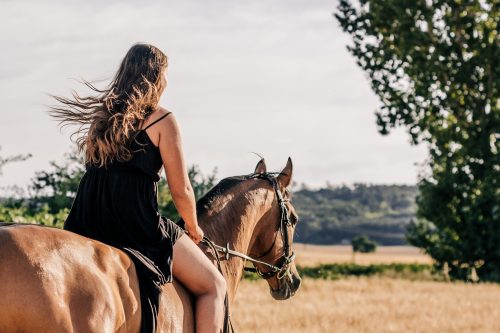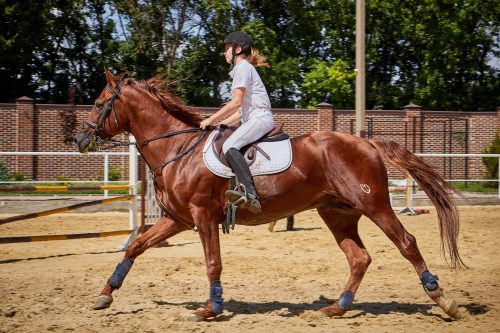Most people are curious to know if horseback riding is bad for the hips. Well, there is only one simple answer which is; YES! it is. Let me tell you why.
Causes Of Pain In Horseback Riding
Most dressage riders develop mild or severe pain in their lower back and hips while riding especially when the seat isn’t positioned to swing freely to prevent holding back the horse’s gallop. This can also be a result of not engaging in stretches and exercises before mounting your horse.

Another cause could be riding a big horse (like the Andalusian mare) having a wide back that makes you spread your legs thereby widening your hips and inner thighs. In this situation, you have no choice than to turn your knees outward which causes a rotation of your upper thigh hence forcing you on your seat bones for balance. This, in turn, intensifies exertion on your spinal cord and hip bones.
Every rider needs to strengthen his/her abdominal or lower-back muscles (1) to avoid developing sore hip flexors. Regular exercises include crunches, oblique twists, and bridge poses which you need to perform to prevent any form of hip dislocation or injury.
In this post, I will introduce several forms of exercises and workouts that you can do to stay healthy and attain a good balance on your dressage no matter the level of rider you are.
Preventive Measures
The best way to prevent any unforeseen accidents or imbalances is by wearing hard helmets, appropriate riding clothing, and shoes with comfortable seats before mounting your dressage. If you spend most of your time sitting in the same position for prolonged periods, then you need to limit this by taking walks and standing more to flex your hip muscles which are usually the affected joints while in a sitting position.
You may also want to consider sticking to a horse with a narrow back to avoid straining your hips on a wider one especially if you have a smaller pelvis. For instance, a woman’s pelvis is wider than that of a man and it is advisable to seat flat while mounted on your horse rather than being sloped downward.
Seat in different saddles and let your coach or personal trainer watch you ride in the variety of saddles. Allow him to choose which saddle suits your body type to help prevent any discomfort and subsequent possible accident.

Here Are The Exercises You Can Indulge In While Enjoying Your Ride:
-
Yoga
Being an ardent rider determines how much time you spend on your horse. Therefore, you need to take your workouts seriously. Yoga is an exercise that involves several poses that help to stretch the hips and every part of your body including your lower back and spine.
Triangle pose and those in the warrior series relax the hips and improve the condition of the central muscles. You must exhibit flexibility in your hip, shoulder, and elbow joints to prevent any form of rigidity thereby allowing your horse to glide underneath you freely.
- Reverse Sits-ups
The required coordination in this exercise is not as mandatory as that of yoga. As you would in a normal sit-up, lie down flat on your back with your knees supple. Raise your knees towards your head with your toes pointing up and your hands placed flat on the floor palms down.
Repeat this motion several times until you feel a loosening in your abs and hips. This is a simple exercise that you can perform without any help or training needed.
- Perpendicular Stretch
Depending on the purpose your horse serves (it could be your hobby to ride a pony or your lifelong ambition to become a dressage rider) sitting at your desk in the office during working hours can result in extra strain on your hip flexor muscles. This stretch helps in easing tension created in the hip joints by both effects from riding and sitting.
With one knee at a right angle, step the foot of that knee out in front of you while resting on the other knee on the floor. Raise the foot behind up with the hand on the opposite side then raise the other hand into the sky. Inhale and squeeze your bottom to feel a uniform stretch through your joints. Remain in that position for a few seconds and repeat by changing your legs and hands, re-positioning yourself to feel the blood circulation in every limb.
- Pigeon Pose
This is a form of exercise that aids the relaxation of your hips and lower back (2). This can be done regularly before you begin to notice any pain in your hip bones before mounting your dressage daily. The first step is to assume a sitting position then extend one bent knee in front of you with the other leg stretched behind you.
Fold the heel of your bent knee into your thigh and fall forward resting your hands on the floor. Hold yourself in this position for a minimum of 10 seconds and repeat while interchanging your legs as you do so.
-
Clamshell
Be in a lying position with your knees at a 45-degree angle bent under your thighs inwards. Make sure your ankles are pressed together then intermittently, open and close your legs thereby forming a clamshell motion which in turn stretches your external hip ligaments.
You may have compressed your thighs around the horse such that too much strain is exerted on your hip flexors. This exercise will help ease the stiffness and relax your muscles.

- Hip Adductor Exercise
Sit in a hard chair that keeps you at a right angle to the floor. Use your thighs to hold on to a ball with at least a diameter of one foot. Ensure your thighs are hanging out of the chair then squeeze the ball between them. Remain in this position for about 20 seconds and increase the timing daily until you have mastered holding the ball between your knees without feeling any discomfort.
This exercise will help in your ability to grip your horse with your thighs effortlessly. If you have left off for some time and plan to get back into riding, this exercise will help you very much. There are hip adductor machines at the gym where you can do more practice if you love the flexibility it gives your muscles.
- Semi Lotus
In this option, you need to assume a sitting position with your legs crossed having one foot on the other knee. Place your hands on the floor resting your body on your shin over the foot on top. You can achieve this exercise by just assuming a cross-legged position without raising your foot to avoid any dislocation while trying to adjust your foot. This pose helps in achieving a relaxed and supple hip joint.
- Deep Thrust
This is amazing in the way it helps in loosening the hip muscles and adductors. Place yourself flat in a lying position and gradually raise your body until one knee is stretched out behind you lifted by the tip of your toes. Keep the other leg raised at the knee while your foot remains flat on the floor.
Rest your hands on the floor in front of you and keep your head bent down ensuring you feel a deep stretch in your inner thighs by taking deep breaths.
Medical Diagnosis And Effective Treatment
It is important to seek immediate medical attention from a professional therapist as soon as you start noticing any malfunctioning of your hip muscles and joints. Sprains and dislocations may result in a diagnosis of complete hip replacement which could mean that the rider will no longer be able to mount a horse ever again.
A therapist is in the best position to take x-rays of your sprained joints to administer the right treatment. Sometimes he/she could administer only injections or regular exercise depending on the severity of the fracture. There are other simple steps to take outside performing exercises already listed in this post which the doctor can recommend ranging from heat application to the pain site for several minutes to deep tissue massages.
Pain relievers in the form of tablets or ointments can also be taken or applied at home under the proper medical prescription of your physiotherapist. A deep tissue massage can be applied by a professional massage therapist using special techniques in achieving relaxation of sore, knotted, tight, or injured muscles. It goes beyond the surface of the skin deep beneath the torn muscles where the dislocation has occurred hence extra pressure is usually applied to reach the actual point where the tension lies.
Hip injury or dislocation can be treated if the damage is not beyond repair otherwise, a total replacement has to be done which could even condemn someone to a wheelchair for the rest of their lives. Take preventive measures to avoid a situation where there is no remedy.
You may be too young to develop any of such mishaps in your lifetime. Older riders you see doing great and having the required stamina follow recommended training by their coach and practice several simple routine exercises before mounting their horses.
Change your attitude of riding recklessly and follow all the points that I have highlighted in this post to secure your future without any risk involved.
Glossary

